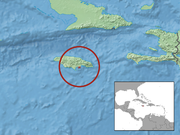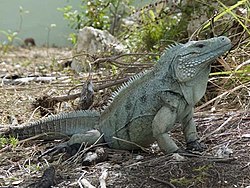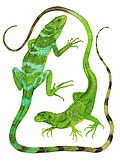Cyclura
| Cyclura | |
|---|---|

| |
| Cyclura cornuta, rhinoceros iguana | |
| Scientific classification | |
| Domain: | Eukaryota |
| Kingdom: | Animalia |
| Phylum: | Chordata |
| Class: | Reptilia |
| Order: | Squamata |
| Suborder: | Iguania |
| Family: | Iguanidae |
| Genus: | Cyclura Harlan, 1825 |
| Type species | |
| Cyclura cornuta | |
Cyclura is a genus of lizards in the family Iguanidae. Member species of this genus are commonly known as "cycluras" (or more commonly as rock iguanas) and only occur on islands in the West Indies.[1] Rock iguanas have a high degree of endemism, with (in most cases) a single species or subspecies originating on an individual island.[2][3]
Taxonomy
[edit]The genus Cyclura was first circumscribed by Richard Harlan in 1825 to include two new species of lizard: C. carinata and C. teres. C. teres eventually turned out to be a junior synonym of Ctenosaura acanthura.[4]
In the 20th century there were eight recognised species of Cyclura and nine additional subspecies (one extinct) besides the nominotypical subspecies.[2][5][6]
Recently, certain subspecies were elevated to species status.[7] Currently, there are ten species in this genus.
| Common name | Scientific name and subspecies | Range | Size and ecology | IUCN status and estimated population |
|---|---|---|---|---|
| Turks and Caicos rock iguana | Cyclura carinata[8] Harlan, 1825 Two subspecies
|
Turks and Caicos islands and Booby Cay, the Bahamas | Size: Habitat: Diet: |
EN
|
| Jamaican iguana | Cyclura collei[8] Gray, 1845 |
Jamaica
|
Size: Habitat: Diet: |
CR
|
| Rhinoceros iguana | Cyclura cornuta[8] (Bonnaterre, 1789) Two subspecies
|
Hispaniola (both Haiti and the Dominican Republic) and surrounding islands | Size: Habitat: Diet: |
EN
|
| Northern Bahamian Rock Iguana | Cyclura cychlura[9] (Cuvier, 1829) Three subspecies
|
Andros Island and the Exuma islands in the Bahamas | Size: Habitat: Diet: |
VU
|
| Grand Cayman ground iguana, Grand Cayman blue iguana or Cayman Island rock iguana | Cyclura lewisi[10] (C. Grant, 1940) |
Grand Cayman | Size: Habitat: Diet: |
EN
|
| Cuban iguana | Cyclura nubila[8] (Gray, 1831) Two subspecies
|
Cuba; introduced to Isla Magueyes, Puerto Rico | Size: Habitat: Diet: |
VU
|
| Anegada ground iguana | Cyclura pinguis[8] Barbour, 1917 |
Anegada and Guana Island in the Virgin Islands; formerly Puerto Rico and Saint Thomas | Size: Habitat: Diet: |
CR
|
| Ricord's iguana | Cyclura ricordii[8] (Duméril & Bibron, 1837) |
Hispaniola and surrounding islands | Size: Habitat: Diet: |
EN
|
| San Salvador iguana | Cyclura rileyi[8] Stejneger, 1903 Three subspecies
|
the Bahamas | Size: Habitat: Diet: |
CR
|
| Mona Island iguana[8] | Cyclura stejnegeri Barbour & Noble, 1916 |
Mona Island, Puerto Rico | Size: Habitat: Diet: |
CR
|
Habitat
[edit]Rock iguanas most often inhabit subtropical zones, of Caribbean island dry forest biomes. These landscapes are characterised by rocky outcrops, rugged cliffs, hills, weather-eroded limestone features and moderate to sparse vegetation; they live in many types of environments, from moderately dry acacia forest, to much hotter mesquite and dry cactus landscapes. The reptiles enjoy sunning themselves on exposed rock faces, since they are naturally cold-blooded animals, and therefore must regulate their internal temperature. Caribbean islands are often made up of heavily weathered limestone, which ultimately forms natural caves for animals to take shelter in.[11]
Diet and longevity
[edit]
All rock iguanas are herbivorous, consuming leaves, flowers, berries, and fruits from different plant species. Their diet is very rarely supplemented with insect larvae, crabs, slugs, dead birds, and fungi; individual animals do appear to be opportunistic carnivores.[3][12]
A study in 2000 by Allison Alberts revealed that seeds passing through the digestive tracts of C. nubila nubila rock iguanas germinate more rapidly than those that do not. These seeds in the fruits consumed by this species have an adaptive advantage by sprouting before the end of very short rainy seasons. She theorised these iguanas may be an important means of distributing such seeds to new areas.[13]
The record for the longest lived captive-born rock iguana is held by a Lesser Caymans iguana, which lived for 33 years in captivity.[14]
A blue iguana captured on Grand Cayman in 1950 by naturalist Ira Thompson was imported to the United States in 1985 by Ramon Noegel and sold to reptile importer and breeder, Tom Crutchfield. Crutchfield loaned this iguana to the Gladys Porter Zoo in Brownsville, Texas in 1997. The lizard was named Godzilla by the zoo staff and was kept until his death in 2004. Thompson estimated the iguana to be 15 years of age at the time of its capture. This lizard may have been the word's longest-living recorded lizard at 69 years of age, having spent 54 years in captivity.[15]
Reproduction
[edit]All species of Cyclura are sexually dimorphic; males are larger than females, and have more prominent dorsal crests as well as larger femoral pores on their thighs, which are used to release pheromones.[16][17]
The particulars vary slightly among species and subspecies, the rock iguanas reach sexual maturity at three to seven years of age. Females become sexually mature at two to five years of age. Males can be highly territorial with the notable exception of the Exuma Island iguana. Mating takes place at the beginning of or just prior to the first rainy season of the year (May to June) and lasts for two to three weeks. Females lay from 2 to 34 eggs, with an average clutch size of 17 within 40 days. Females of most species guard their nests for several days after laying their eggs, and incubation lasts approximately 85 days. It has been noted that Cyclura eggs are among the largest lizard eggs produced in the world.[16]
Conservation
[edit]In 1996 nine of these taxa were assessed as critically endangered, four taxa are endangered and three species have been identified as vulnerable; one subspecies is believed to be extinct. In addition to small numbers typical of endemic island-dwelling animals, wild populations of these lizards are directly and indirectly impacted by land development, overgrazing by domestic and feral livestock and predation by introduced mammals such as hogs, cats, rats, dogs, and mongooses.[2]
In 1990, the American Zoo and Aquarium Association (AZA) designated the genus Cyclura as their highest priority. Their first project was a captive breeding program for the Grand Cayman iguana, which at the time was the most critically endangered of all the species of Cyclura.[18]
The Indianapolis Zoo was involved in research and conservation of all sixteen taxa of West Indian iguanas. This includes collaborative work on establishing baseline biological information in captive and wild iguanas, scientific investigation, conservation efforts, field research and captive breeding programs.[18]

References
[edit]- ^ Dayhuff, Becky (2006-02-01), "Rock Iguanas of the Caribbean", All at Sea Magazine[permanent dead link]
- ^ a b c Malone, Catherine; Davis, Scott (2004), "Genetic Contributions to Caribbean Iguana Conservation", Iguanas: Biology and Conservation, University of California Press, pp. 45–57, ISBN 978-0-520-23854-1
- ^ a b Blair, David (1991), "WEST INDIAN IGUANAS OF THE GENUS Cyclura Their Current Status in the Wild, Conservation Priorities and Efforts to Breed Them in Captivity" (PDF), Northern California Herpetological Society Special Publication, vol. SE, no. 6, pp. 55–56, archived from the original (PDF) on 2008-04-11
- ^ Harlan, Richard (1825). "Description of two Species of Linnæan Lacerta, not before described, and construction of the new genus Cyclura". Journal of the Academy of Natural Sciences of Philadelphia. Series 1. 4 (2): 242–251. Retrieved 22 February 2020.
- ^ Schwartz, A.; Carey, M. (1977). "Systematics and evolution in the West Indian iguanid genus Cyclura" (PDF). Studies on the Fauna of Curaçao and Other Caribbean Islands. 53 (173): 15–97.
- ^ "Cyclura: Harlan, 1825", Integrated Taxonomic Information System, 2001, retrieved 2007-10-07
- ^ "Cyclura stejnegeri". The Reptile Database. Retrieved 2021-07-06.
- ^ a b c d e f g h i j k l m Hollingsworth, Bradford D. (2004), "The Evolution of Iguanas: An Overview of Relationships and a Checklist of Species", Iguanas: Biology and Conservation, University of California Press, pp. 35–39, ISBN 978-0-520-23854-1
- ^ Cyclura cychlura, The Reptile Database
- ^ Burton, Frederic (2004), "Taxonomic Status of the Grand Cayman Blue Iguana" (PDF), Caribbean Journal of Science, vol. 8, no. 1, pp. 198–203, archived from the original (PDF) on 2007-10-25, retrieved 2007-09-16
- ^ Knapp, Charles R.; Hudson, Richard D. (2004), "Translocation Strategies as a Conservation Tool for West Indian Iguanas", Iguanas: Biology and Conservation, University of California Press, pp. 199–209, ISBN 978-0-520-23854-1
- ^ Alberts, Allison (9 December 2004). The Grand Cayman Blue Iguana – Species Recovery Plan 2001–2006 (PDF). Grand Cayman: Blue Iguana Recovery Program. p. 29. Archived from the original (PDF) on 10 June 2016. Retrieved 2007-09-08.
- ^ Alberts, Allison; Lemm, Jeffrey; Grant, Tandora; Jackintell, Lori (2004), "Testing the Utility of Headstarting as a Conservation Strategy for West Indian Iguanas", Iguanas: Biology and Conservation, University of California Press, p. 210, ISBN 978-0-520-23854-1
- ^ Iverson, John; Smith, Geoffrey; Pieper, Lynne (2004), "Factors Affecting Long-Term Growth of the Allen Cays Rock Iguana in the Bahamas", Iguanas: Biology and Conservation, University of California Press, p. 184, ISBN 978-0-520-23854-1
- ^ Adams, Colette (May 26, 2004), "Obituary" (PDF), Iguana Specialist Group Newsletter, 7 (1): 2, archived from the original (PDF) on August 12, 2007, retrieved October 5, 2007
- ^ a b De Vosjoli, Phillipe; David Blair (1992), The Green Iguana Manual, Escondido, California: Advanced Vivarium Systems, ISBN 1-882770-18-8
- ^ Martins, Emilia P.; Lacy, Kathryn (2004), "Behavior and Ecology of Rock Iguanas,I: Evidence for an Appeasement Display", Iguanas: Biology and Conservation, University of California Press, pp. 98–108, ISBN 978-0-520-23854-1
- ^ a b Hudson, Richard D.; Alberts, Allison C. (2004), "The Role of Zoos in the Conservation of West Indian Iguanas", Iguanas: Biology and Conservation, University of California Press, pp. 274–289, ISBN 978-0-520-23854-1
External links
[edit]- All about Cycluras
- Father Sanchez's Website of West Indian Natural History
- Blue Iguana Recovery Program (B.I.R.P.)
- the International Reptile Conservation Foundation
- the Durrell Wildlife Conservation Trust
- Reptile Stamps - Stamps featuring pictures of West Indian iguanas











